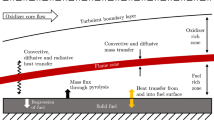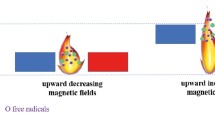Abstract
We calculate the efficiency at maximum power (EMP) of an isothermal chemical cycle in which particle uptake occurs at a fixed chemical potential but particle release takes place at varying chemical potential. We obtain the EMP as a function of Δμ/kT, where Δμ is the difference between the highest and lowest reservoir chemical potentials and T is the absolute temperature. In the linear response limit, Δμ ≪ kT, the EMP tends to the expected universal value 1/2.
Similar content being viewed by others
References
B. Cleuren, B. Rutten, C. Van den Broeck, Universality of efficiency at maximum power, Eur. Phys. J. Special Topics 224, 879 (2015) and other papers in the same Special Topics issue
C. Van den Broeck, Thermodynamic efficiency at maximum power, Phys. Rev. Lett. 95, 190602 (2005)
M. Esposito, K. Lindenberg, C. Van den Broeck, Universality of efficiency at maximum power, Phys. Rev. Lett. 102, 130602 (2009)
C. Van den Broeck, Efficiency at maximum power in the low-dissipation limit, Europhys. Lett. 101, 10006 (2013)
For a historical perspective, see M. Moreau, Y. Pomeau, Carnot principle and its generalizations: A very short story of a long journey, Eur. Phys. J. Special Topics 224, 769 (2015)
For a historical perspective, see A. Calvo Hernandez, J.M.M. Roco, A. Medina, S. Velasco, L. Guzman-Vargas, The maximum power efficiency 1 − √_τ: Research, education, and bibliometric relevance, Eur. Phys. J. Special Topics 224, 809 (2015)
C. Van den Broeck, N. Kumar, K. Lindenberg, Efficiency of Isothermal Molecular Machines at Maximum Power, Phys. Rev. Lett. 108, 210602 (2012)
F. Curzon, B. Ahlborn, Efficiency of a Carnot engine at maximum power output, Am. J. Phys. 43, 22 (1975)
L. Chen, C. Sun, C. Wu, J. Yu, Performance characteristic of isothermal chemical engines, Energy Convers. Manage. 38, 1841 (1997)
H. Hooyberghs, B. Cleuren, A. Salazar, J.O. Indekeu, C. Van den Broeck, Efficiency at maximum power of a chemical engine, J. Chem. Phys. 139, 134111 (2013) [See also the Publisher’s note, J. Chem. Phys. 140, 209901 (2014)]
Author information
Authors and Affiliations
Corresponding author
Rights and permissions
About this article
Cite this article
Koning, J., Koga, K. & Indekeu, J.O. Efficiency at maximum power for an isothermal chemical engine with particle exchange at varying chemical potential. Eur. Phys. J. Spec. Top. 226, 427–431 (2017). https://doi.org/10.1140/epjst/e2016-60200-8
Received:
Revised:
Published:
Issue Date:
DOI: https://doi.org/10.1140/epjst/e2016-60200-8




